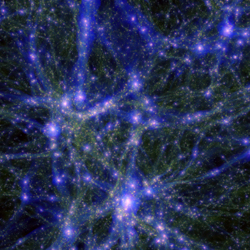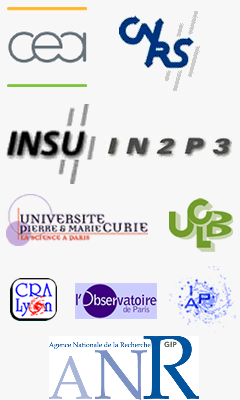
The site's hierarchy
Navigation
| M | T | W | T | F | S | S |
|---|---|---|---|---|---|---|
| 23 | 24 | 25 | 26 | 27 | 28 | 1 |
| 2 | 3 | 4 | 5 | 6 | 7 | 8 |
| 9 | 10 | 11 | 12 | 13 | 14 | 15 |
| 16 | 17 | 18 | 19 | 20 | 21 | 22 |
| 23 | 24 | 25 | 26 | 27 | 28 | 29 |
| 30 | 31 | 1 | 2 | 3 | 4 | 5 |
- Dark Energy Universe Simulation Series (DEUSS) down to z=0.
- We have completed a series of nine billion-particle simulations for three different dark energy cosmologies. It resolve scale from 4 kpc to 4 Gpc and halo masses from 3.10^10 Msun to 8.10^15 Msun. More info is given here.
- DEUSS
- CINES received a 150 TFlops machine
- GENCI has acquired for the French University Supercomputing Center a 12288 core SGI Altix. It is ranked 14th in the World and first in France.
- Site Web du CINES
- IDRIS received a 140 Tflops BlueGene/P machine.
- The CNRS supercomputing centre has acquired a new BlueGene machine with 40480 processors and 20 To of RAM memory.
- See the press release.
- Mare Nostrum simulation down to z=1.55
- We carried out our fourth run of MareNostrum down to z=1.55 while producing 150 Million "stars". More info is given here
- Horizon 4Pi 4096^3 down to z=0
- We have carried a full sky 2Gpc/h 4096^3 Dark Matter simulation down to z=0. More details can be found here
- Horizon 4Pi run 2048^3 completed
- We have completed a full sky cone run of DM with RAMSES on platine CEA with 2048^3 particles. See a slice here
- Mare Nostrum @ z=1.9
- We carried out our third run of MareNostrum down to z=1.9 while producing 120 Million "stars"
- Mare Nostrum simulation down to z=2.4
- We carried our second run on the Mare Nostrum supercomputing center down to z=2.4, thanks to 4-fold improvement in overall performance.
- 1024^3 500 h-1Mpc simulation completed
- RAMSES run of the HORIZON initial condition was carried down to z=0 using 1024^3 dark matter particles in a (500 Mpc/h)^3 box with up to 16 levels of refinement (corresponding to local effective resolution of 65536).
- Horizon 1024^3 100 Mpc/h simulation completed.
- A RAMSES run of the HORIZON initial condition was carried down to z=0 using 1024^3 dark matter particles in a (100 Mpc/h)^3 box with up to 16 levels of refinement (corresponding to local effective resolution of 65536).
- A 43 Tflops supercomputer at CEA
- CCRT, the supercomputing centre of CEA, has just received a new BULL supercomputer with 6800 processors and 13.6 Tb of RAM memory. This facility is dedicated to academic and industrial research.
- Lire le communiqué
- MareNostrum simulation published in HPCWire
- Lire l’article
- Fourth Horizon Workshop 2006b
- The 4th workshop takes place from December, the 11th to December, the 12th at Paris Observatory. Registration form available here.
- MareNostrum simulation has started at BSC
- After 1 week of operations, we have reached redshift 4. The simulation will proceed further more during the next quarters. We have started to post-process these initial data.
- Horizon Grid
- The Horizon grid is now in operation. It links the 6 quadri opteron of Meudon, Paris, Lyon, Saclay, IAP and Marseille and is open to all members of the collaboration. Voir ce lien
- http://grille.projet-horizon.fr
- Third Horizon Workshop 2006a
- Horizon Workshop 2006a 10, 11 and 12 april 2006 in Lyon. It will be dedicated to progress reports. Registration form
- Horizon is part of the DEISA "Extreme Computing Initiative"
- Horizon will launch one extreme application for galaxy formation using the DEISA infrastructure at Mare Nostrum http://www.bsc.es
- DEISA web site
- Second Horizon Workshop
- Horizon Workshop 2005 took place at Paris Observatory the 14th and 15th november. It was dedicated to internal discussions and management issues.
- October 2005: Horizon was awarded a 500 k€ grant by ANR, the French Science Foundation.
- Horizon response to «ANR Blanche» Call for Proposals has been succesfull in the «UNIVERS» program.
- ANR web site
- July 2005: HP France was selected to host the Horizon "meso-computer"
- HP company has succesfully answered the "call for proposals" issued by the Hrizon Project for a medium-size dedicated super-computer. The computer will be hosted at HPC1, the HP high performance computing center near Paris.
- February 2005: INSU and CEA agree to fund the Horizon "meso-machine".
- Horizon has submitted to INSU a proposal for funding a medium-size computer dedicated to the project. The proposal was accepted as a joint CEA and INSU operation.
- September 2004: Kick-off meeting in Paris
- During 3 days (13, 14 and 15 of september), 30 scientists have met at Observatoire de Paris to set up the basic organisation and objectives of the Horizon Project.
- KO Meeting
- April 2004: Horizon received official support from ASSNA.
- The french initiative «Action Spécifique pour les Simulations Numériques en Astrophysique» have given to the Horizon project its "label" for outstanding and structuring computational project.
- April 2004: The french Astroparticule program provides financial support for the Horizon "mini-grid"
- The Programme Astro-Particule, a joint IN2P3 and INSU initiative, has agreed to finance 6 quad AMD64 servers dedicated to the Horizon Project.
- January 2004: Review by PNC and PNG
- Both PNG and PNC scientific comitees are officially supporting the Horizon Project initiative.
- Theoretical Virtual Observatory workshop (IAP April 5-6, 2006)
A workshop dedicated to the Theoretical Virtual Observatory will take place at IAP on April 5-6th.
The goal is to bring together experts of the Virtual Observatory and theoreticians who would like to make results of their simulations (e.g. databases or catalogs) or numerical codes available to the worldwild astronomical community.
- Program and speakers
The Horizon Project
Scientific Highlights:
![]() the Horizon simulation performed at CCRT (CEA)
the Horizon simulation performed at CCRT (CEA)
![]() the MareNostrum simulation performed at BSC (Spain)
the MareNostrum simulation performed at BSC (Spain)
![]() the GALMER database is now online.
the GALMER database is now online.

The objective of the HORIZON Project is to federate numerical simulations activities with a program focussed on Galaxy and Large Scale Structure Formation. In a context favorable to HPC (High Performance Computing), the PNC (Programme National Cosmologie), the PNG (Programme National Galaxies) and the PAP (Programme AstroParticule), express their needs to stimulate and coordinate individual efforts in HPC among each domain.
The HORIZON Project was build on several research teams in different institutes. The scientific objective is specifically oriented towards studying galaxy formation in a cosmological framework. Its transverse and federative nature will however allow to develop in a few years high-level expertise in parallel and distributed (GRID) computing, in database management and virtual observations, in applied mathematics and computer science, and build in the same time a strong theoretical knowledge in astrophysics.
The main objectives are:
- Numerical study of galaxy formation in a cosmological framework using Grand Challenge applications
- Develop advanced techniques in parallel computing and in applied mathematics to model galaxy formation and predict their observational signatures, as a function of physical parameters
- Gather renowed experts in computational astrophysics, share their softwares and expertise, and optimize their access to national and international supercomputing facilities
- Provide to the scientific community, and in particular to the AstroParticle, PNC and PNG communities (both observers and theoreticians), a friendly access to state-of-the-art numerical simulations

